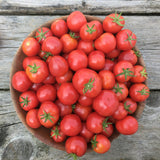Plate de Haiti Tomato
Solanum lycopersicum
Please also check out the African Diaspora Collection Seed Packets and Postcards bundle.
Prolific, vermilion red, apple-shaped tomato that has been associated with Hispaniola since the 1550s. Right up until frost, this indeterminate tomato produces endless 2-inch fruits that are flavorful when eaten fresh, and even better in sauce. According to William Woys Weaver who shared the seeds with Pentridge Children's Garden, this variety was first documented in Conrad Gessner's Historia Plantarum in 1561. In 1793, the Creole refugees who fled the successful uprising of enslaved people in Haiti brought this tomato with them. Dr. Weaver was able to find this tomato depicted in paintings of that time period made by the Peale family of Philadelphia, well before it became a popular food in North America (see Still Life: Balsam Apples and Vegetables, 1820 by James Peale). The kids at Pentridge Children's Garden in West Philadelphia explore the history of the Haitian Revolution while growing and eating this tomato. Our packets were illustrated by Jasmine Hamilton, and feature Marie-Jeanne Lamartiniére of of the revolutionary Haitian soldiers.
Soul Fire Farm remits 100% of their proceeds from the sales of their seeds to the Stockbridge Munsee Band of the Mohican Nation.
Days to maturity: 80
Seeds per pack: 25
Germination rate: 98% on 01/17/2025
Planting / harvesting notes
Start seeds 6-8 weeks before the last frost and transplant into garden well after the danger of frost. We recommend you prune the suckers that form in the crotches of the branches by the main stem. Water tomatoes at the soil level, keeping the leaves dry.
Seed keeping notes
Tomatoes are generally self-pollinating, though we isolate different varieties by 35-50 feet, in hopes that flying insects will not cross pollinate them unexpectedly. Tomato seeds are ripe when the fruits are ready to eat! Cut the fruit at the equator and squeeze or scrape out seeds from each of the cavities. In a cup or bucket, add a little water (1/2" is probably plenty) to your seeds and pulp to keep them from drying out, and allow them to ferment away from direct sunlight. Ideally, you will stir the concoction every day for 3-5 days. In the end, add more water to fill the vessel, stir one final time, and allow to settle. Pour off the floating material and then strain the seeds through a strainer. Sometimes, you will need to add more water and pour off the floating material several times until the water is clear and you can see the seeds sunken at the bottom. Squeeze dry the strained seeds in a towel, and then lay out to dry on a labeled screen or paper product in a ventilated place away from direct sunlight for a week or two.









